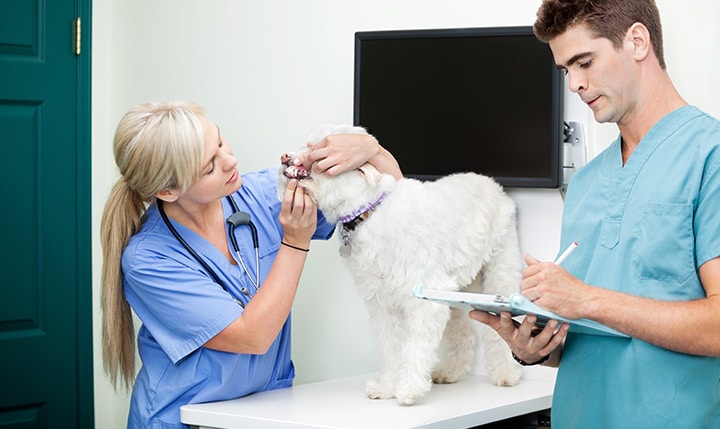With the summer underway and deer ticks searching for hosts, dog owners will want to know how to identify symptoms of Lyme disease and how to prevent their dog from contracting the disease. Lyme disease in dogs is treatable but can be a serious issue when the infection leads to other harmful medical issues.
Lyme disease ( borreliosis) stems from Borrelia burgdorferi, a specific bacteria called spirochete which is carried by deer ticks. The disease was first diagnosed in Lyme, Connecticut in 1975, but cases have been documented in all 50 states. This is most likely from people traveling to endemic areas—regions where tick populations are prevalent—and returning to their home state. There is evidence that Lyme disease has existed in the wild long before humans discovered the issue.
The eastern coastal regions that are close to densely wooded areas and have high populations of white-tailed deer have a significantly higher prevalence of Lyme disease. Upstate New York, Massachusetts, and Minnesota are states with high concentration levels of deer ticks. If your dog plays outside in the summer months, you\’ll want to take extra precaution.
How is Lyme Disease in Dogs Transmitted?
The transmission of Lyme disease is dependent on the life cycle of the black-legged deer tick. The tick goes through three stages in life. In the spring, the larvae hatch from eggs and will find a host to feed on—a small mammal like the white-footed mouse. If the mammal the tick latches itself onto is infected, the larvae will also become infected.
When the cool weather comes the larvae will winter over and wait to find another host for the spring as a nymph. Once attached to another mammal, the nymph can molt and reach the final stage of adulthood. Deer ticks get their name because they are most commonly attach themselves to the white-tail deer that rub up against vegetation the ticks are waiting on. Deer ticks can attach themselves to humans, dogs, and any other mammal walking through forested areas.
Symptoms of Lyme Disease in Dogs
An infected tick must be attached to a dog for 48 hours for the transmission of the disease to contract. If the tick is removed before this, the infection will not be contracted. This makes checking your dog for ticks a good practice.
Only 5-10% of infected dogs develop symptoms. Lameness, due to inflammation of the joints, is the most common medical symptom of Lyme disease. What makes the disease even more potentially harmful are the other medical complications that derive from infection.
Progressive kidney disease, nervous system disease, and heart complications can occur after transmission of Lyme disease. If you spot any of these symptoms in your dog\’s behavior, please seek out veterinary services immediately. Senior dogs with Lyme disease and arthritis will be in more severe pain than younger dogs. The inflammation of their joints can impair their mobility.
Other Symptoms Include:
- Stiffness
- Arched Back
- Difficult Breathing
- Fever
- Loss of Appetite
- Depression
- Superficial Lymph nodes around the area of the bite.
- Heart Abnormalities
- Nervous System Complications
Humans can also contract Lyme disease so if your pet is diagnosed you will also want to contact your physician. Your dog can bring in a tick from outdoors or chances are you hiked the same area of tick infested land.
How Are Dogs Treated?
Your veterinarian will administer a series of blood tests to detect certain antibodies developed by a dog infected with the B. burgdorferi bacteria. Many dogs\’ blood tests come back positive even if your dog has not contracted Lyme disease. Exposure to Borrelia burgdorferi will yield a positive blood test result. Most likely the dog was exposed to the bacteria but was able to fight the infection off without treatment.
Treating Lyme disease is straightforward. Veterinarians will prescribe a tetracycline or penicillin based antibiotic. Dogs will need to take the antibiotics for at least 14 days, but a 30-day regimen is recommended to sufficiently clear the organism. There have been a few cases where after 30 days of antibiotic treatment a dog has relapsed and will never completely rid themselves of the infection. However, the majority of animals that receive antibiotics respond well to treatment.
Prevention & How to Check Your Dog for Ticks
During tick season be aware of areas that could have tick infestations and monitor your dog\’s coat after hiking through thick brush.
Tick Control:
- Vaccination. If your dogs live in an eastern coastal state near the woods it might be worth getting your dog vaccinated. However, some medical experts have criticized vaccinating for Lyme disease in dogs, stating that is ineffective.
- Topical Insecticides. There are various effective insect repellents on the market like K-9 Advantix or Spot On for Dogs. Applying these to your dog will ensure that if a tick bites your dog it will die and release within 12 hours.
- Tick Collars. Using a tick collar with the active ingredient Amitraz which will repel ticks but not fleas.
After your dog adventures outside look for red irritated areas that are inflamed. This could be a possible tick bite. Check your dog\’s coat by running your fingers through their coat like a comb feeling for lumps as you go. If you see any bumps, make note of its position but do not force a comb through the area. This will make the bite more painful. You will also need to check their ears with a flashlight. If your dog is showing any symptoms of Lyme disease, please seek out a veterinary diagnosis.
Follow Splash and Dash Groomerie & Boutique:
- Website: http://splashanddashfordogs.com/
- Website: https://splashanddashfranchise.com/
- Facebook: https://www.facebook.com/splashanddashfordogs/
- Instagram: @splashanddashfordogs
- LinkedIn: https://www.linkedin.com/in/dan-j-barton-622ab517
- Twitter: splashanddash4dog



